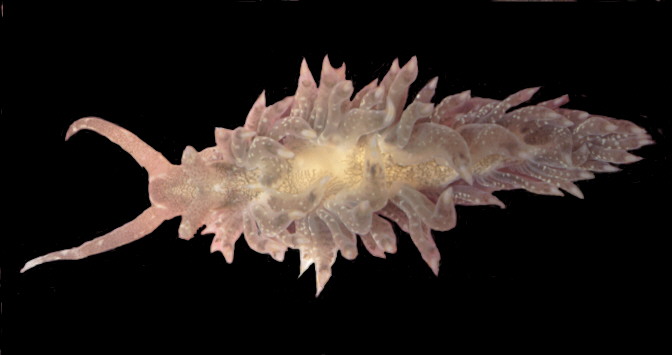
| Berghia major Bahia de Los Angeles Baja California Sept. 1997 Courtesy of Dr. Hans Bertsch |
Berghia major (Elliot, 1903)
Nudibranchs rarely get press, media coverage or become dinner table discussion, but Berghia major has broken the silence of the musty back rooms of aquarium suppliers across the country. As the popularity of "Live Rock" coral gardens has increased in those gorgeous living room aquariums everywhere, so has come a tiny pest, damping the enthusiasm of their dedicated custodians.
What does this have to do with Berghia? Hang in there with me. The pest haunting those owners of live rock aquaria is the stinging anemone, commonly known as the Glassrose anemone, or scientifically as Aiptasia. Also referred to as the reef-wrecking anemone, this species stings and kills any coral polyp it touches. For those aquarists who have committed large amounts of money and most of their awake hours to establishing breath taking coral gardens, this critter, from across the tracks, is certainly not welcome.
Berghia to the rescue. Julian Sprung and Charles Delbeek report in both volumes of their comprehensive new book The Reef Aquarium that Berghia is being cultured for distribution to aquarium stores, in an effort to provide the hobbyist a means of eradicating this pest from their aquaria. Having recommended this biological control measure to several wholesale aquarium suppliers years ago I am pleased that some progress is being made. Nudibranchs to the rescue, I kinda like that.
Now who is Berghia major, other than the renowned hunter of Aiptasia? It is a small and somewhat cryptic aeolid nudibranch having a very wide distribution. Berghia major occurs from the Seychelles and Tanzania to Australia, Japan, Hawaii and tropical North America, the specimen shown here was shot in the Gulf of California. It has long cephala tentacles, perfoliate rhinophores and characteristic cerata, being curved and flattened. While its colors are usually subdued grey, brown and green, they are often highlighted with blue and yellow markings.
Aquarists have wanted to maintain nudibranchs in their tanks for years, but have been unsuccessful because of an inability to provide adequate food for the branchs. Maybe this is the opportunity they have been looking for.

David W. Behrens
Author:
Pacific Coast Nudibranchs
Send Dave mail at seachalleng@earthlink.net
|
© The Slug Site, Michael D. Miller 1998 All Rights Reserved.
